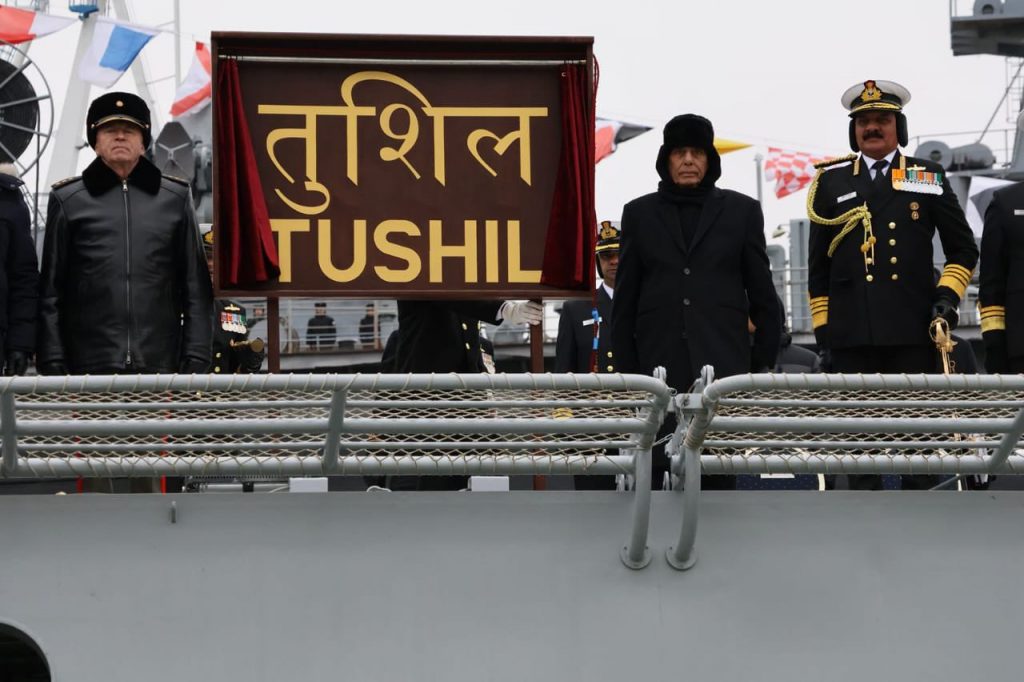New Delhi: Indian Navy’s Russian-manufactured guided missile frigate INS Tushil was commissioned into the force at Russia’s coastal city of Kaliningrad in presence of Defence Minister Rajnath Singh on Monday.
The warship is expected to significantly bolster the Indian Navy’s operational capability in the Indian Ocean, a region that has witnessed increasing forays by China’s PLA Navy in the last few years.
In his remarks, Singh described the commissioning of the warship as a “proud testament” to India’s growing maritime strength and a “significant milestone” in the long-standing friendship between the two countries.
“The ship is a big proof of the collaborative prowess of Russian and Indian industries. It exemplifies India’s journey towards technological excellence through jointmanship,” he added.
Chief of Naval Staff Admiral Dinesh K Tripathi, Russia’s deputy defence minister Alexander Vasilyevich Fomin and Commander-in-Chief of the Russian Navy Admiral Aleksandr Alekseyevich Moiseyev were present at the commissioning ceremony.
INS Tushil has been constructed in Russia as part of an over USD 2.5-billion deal that New Delhi had inked with Moscow in 2016 for four stealth frigates for the Indian Navy.
Under the deal, two ships were to be built in Russia, while the other two were to be manufactured in India.
Singh said India and Russia will enter a “new era” of cooperation by taking advantage of each other’s expertise in areas such as artificial intelligence, cyber security, space exploration and counter-terrorism.
The defence minister said the India-Russia friendship is bound by “mutual trust, and special and strategic privileged partnership”.
The 3,900-tonne ship with a length of 125 metres packs a lethal punch and is an impressive blend of Russian and Indian cutting edge technologies and best practices in warship construction.
In his address at the commissioning ceremony, Singh highlighted the deep ties between the navies of India and Russia and stated that technical and operational collaboration is constantly touching new heights.
The defence minister also reasserted the Indian Navy’s commitment to peace and security in the Indian Ocean Region (IOR), saying it has foiled the “designs” of arms and drug smugglers and non-state actors in various hotspots.
“From the Gulf of Oman to the Gulf of Aden, from Suez to Malacca and from Australia to Madagascar, the Indian Navy is playing the essential role of a net security provider in the IOR,” he said.
“India, along with its friendly countries, believes in ensuring that maritime trade in the region remains safe and secure, thereby promoting unhindered trade across the sea,” he said.
The defence minister also reiterated the Indian Navy’s commitment to realise Prime Minister Narendra Modi’s vision of Security and Growth for All in the Region (SAGAR).
Singh said this vision is the “backbone” of India’s maritime policy that aims to promote peace, stability and economic prosperity in the IOR.
“SAGAR is a symbol of India’s commitment towards collective security, maritime cooperation and sustainable development. In this commitment, we have always received Russia’s support,” he said.
Officials said INS Tushil’s new design provides it with enhanced stealth features and better stability characteristics.
With the collaboration of Indian naval specialists and Severnoye Design Bureau, the indigenous content of the ship has been enhanced to an impressive 26 per cent, the officials said.
INS Tushil is joining the Western Fleet of the Indian Navy and will rank amongst the most technologically advanced frigates in the world, they said.
The major Indian defence firms involved in the project were BrahMos Aerospace Private Limited, Bharat Electronics Limited, Keltron, Nova Integrated Systems from Tata, Elcome Marine, Johnson Controls India and others.
INS Tushil is an upgraded Krivak III class frigate of Project 1135.6.
The warship is the result of the continuous toil of hundreds of shipyard workers along with multiple Russian and Indian Original Equipment Makers (OEMs), said one of the officials cited above.
PTI
